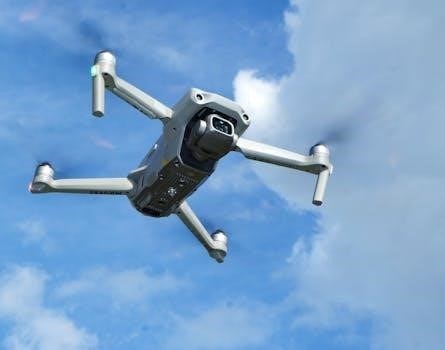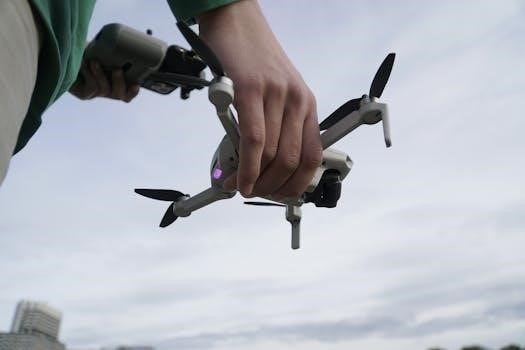
daikin air conditioner remote control manual
This manual provides essential information for operating your Daikin air conditioner using the remote controller. It includes safety precautions, component descriptions, and detailed instructions for various functions. Please read it carefully to ensure optimal use and longevity of your device.
Daikin remote controllers are designed to provide seamless and intuitive control over your air conditioning system. These devices offer a range of functionalities, allowing users to adjust temperature, fan speed, and operation modes with ease. The remote controllers are engineered for user convenience, featuring clear displays and ergonomic button layouts. They act as the primary interface for interacting with your Daikin air conditioner, ensuring comfortable and energy-efficient climate control. Understanding the capabilities of your remote controller is crucial for maximizing the performance and lifespan of your air conditioning unit. Daikin’s remote controllers are available in various models, some offering additional features like smart control and advanced timer settings. These controllers often incorporate features such as directional infrared transmitters for reliable communication with the indoor unit; The remote controllers are designed to be user-friendly, so even first-time users will find them easy to use. Furthermore, Daikin continues to innovate in remote controller technology, ensuring that users have the best possible experience when using their air conditioner.

Safety Precautions When Using the Remote
It is crucial to observe safety precautions while using your Daikin remote controller to prevent damage and ensure your well-being. Never expose the remote to excessive water or moisture as this could cause electrical shock or short circuits. Avoid touching the remote with wet hands, and ensure it is stored in a dry environment. Do not install the remote in places where flammable gases might be present, as this poses a fire hazard. Be cautious not to drop or apply excessive pressure on the device, as this can damage internal components. If the remote becomes damaged or malfunctions, discontinue use immediately and consult a qualified technician. Avoid using the remote near powerful electromagnetic fields, which can interfere with its functionality. Always keep the remote out of reach of children and pets to prevent accidental damage or ingestion of small parts. Regularly inspect the remote for any signs of wear or damage, and replace batteries promptly to prevent leakage that could damage the remote. Using the remote safely helps maintain its functionality and ensures safe operation of your air conditioner.
Remote Control Components and Their Functions
The Daikin remote controller features several components, each with specific functions to control your air conditioner. The power button is used to turn the unit on or off, while the mode button allows you to select between various operating modes such as cool, heat, fan, or dry. The temperature adjustment buttons, usually marked with up and down arrows, let you set your desired room temperature. The fan speed button allows you to control the airflow rate, typically with options like low, medium, and high. A timer button enables you to set the air conditioner to turn on or off at specific times. Some remotes also include a ‘smart control’ button, which enables or disables advanced features. The display screen shows current settings including temperature, mode, and fan speed. The remote also has an infrared transmitter that sends signals to the indoor unit. Knowing each component’s function is crucial for effective and convenient operation of your Daikin air conditioner.
Power Button and Operation Modes

The power button on your Daikin remote controller is the primary control for turning your air conditioner on and off. Pressing this button will activate or deactivate the unit. Once the air conditioner is powered on, you can choose from several operation modes using the mode button. These modes typically include ‘Cool’ for cooling the room, ‘Heat’ for warming the room, ‘Fan’ for circulating air without heating or cooling, and ‘Dry’ for dehumidifying the air. The specific modes available may vary depending on your Daikin model. Each mode optimizes the unit’s performance for its intended purpose. For example, ‘Cool’ mode will engage the compressor to lower the room temperature, while ‘Fan’ mode will only run the fan to circulate air. Selecting the appropriate mode is crucial for maximizing energy efficiency and comfort. The currently selected mode is usually displayed on the remote’s LCD screen.
Temperature Adjustment Settings
The temperature adjustment settings on your Daikin remote controller allow you to precisely control the desired room temperature. You’ll typically find dedicated up and down buttons, or arrow keys, for increasing or decreasing the set temperature. The current set temperature is displayed on the remote’s LCD screen. The temperature range available for adjustment usually varies depending on whether you are in cooling or heating mode. When in cooling mode, the minimum temperature might be around 18°C or 64°F, while in heating mode, the maximum temperature might be around 30°C or 86°F. It’s important to choose a comfortable temperature that also optimizes energy consumption. Some models may also include a ‘Setback’ feature, which allows the temperature to automatically adjust within a certain range to save energy when the room is unoccupied. Remember that the actual room temperature may vary slightly from your set temperature, so minor adjustments may be necessary to achieve the perfect comfort level. The remote control ensures accurate temperature regulation for your environment.

Fan Speed and Airflow Control
The fan speed and airflow control settings on your Daikin remote controller offer multiple options to customize the air circulation in your room. Typically, you will find a dedicated fan speed button that cycles through different levels such as low, medium, high, and sometimes an auto mode. The auto fan speed setting will adjust the fan speed based on the temperature difference between the set temperature and the current room temperature. This can help maintain a consistent and comfortable environment. Some Daikin remote controllers also offer the ability to adjust the direction of the airflow, either vertically or horizontally, using swing or louvre buttons. This functionality allows for directing the airflow to different parts of the room, enhancing comfort and air distribution. Proper use of fan speed and airflow settings can help maximize the efficiency of your air conditioner while maintaining comfortable conditions. Selecting the appropriate fan speed and airflow settings contributes to a more pleasant and efficient cooling or heating experience. It is important to note that high fan speed settings can result in a higher level of noise.
Timer Functionality and Settings
The timer function on your Daikin remote controller allows you to schedule your air conditioner to turn on or off at specific times, providing convenience and energy savings. Typically, the timer settings involve using buttons to set the desired time for activation or deactivation. Many models allow you to set both an on-timer and an off-timer, enabling precise control over the air conditioning schedule. You can set the timer for a single event or for recurring events, depending on the model. Some Daikin remote controllers also offer a sleep timer mode, which gradually adjusts the temperature over time, ensuring a comfortable night’s rest while saving energy. To set the timer, you generally need to press a designated timer button and then use the up and down buttons to adjust the hours and minutes. Once the desired time is set, the air conditioner will automatically turn on or off as scheduled. It is very important to ensure that the remote controller display shows the timer indicator to confirm that it is set correctly. The timer feature is useful for automatically switching the air conditioner on or off at pre-determined time.
Using the Smart Control Button
The smart control button on your Daikin remote controller enables advanced functionalities, often tailored to optimize energy efficiency and user comfort. This button typically activates or deactivates smart features, which can vary depending on the specific Daikin model. For instance, some smart controls enable automatic temperature adjustments based on room conditions or even user preferences that are learned over time. Pressing the smart control button often toggles between different pre-set modes designed to provide the most efficient and comfortable environment. Some models may use this button to activate a special energy-saving mode, automatically adjusting settings to minimize power consumption. On other models, the smart button can be used to activate or disable advanced sensor functionalities, which may detect occupancy and adjust the air conditioner output accordingly. To use the smart control button, press it once to activate the smart mode. You may notice a change in the display to indicate that it is active. To turn it off, press the button again, or press and hold it for a few seconds. This smart function avoids the need for troublesome remote control operations. It allows you to simply take control of your climate using pre-set configurations.
Troubleshooting Common Remote Control Issues
If your Daikin remote control isn’t functioning correctly, several common issues might be the cause. First, ensure the batteries are properly installed with the correct polarity and that they have sufficient charge. Low batteries are a frequent cause of remote malfunction. If you have recently replaced the batteries and it’s still not working, they may be defective or incompatible with your remote. Next, confirm that there is no obstruction between the remote and the indoor unit of the air conditioner. Curtains, furniture, or other objects can block the signal transmission. The maximum transmission distance is usually around 7 meters, so ensure you are within range. If the remote control still isn’t responding, try cleaning the infrared transmitter on the remote’s front end with a soft cloth. Dust or dirt accumulation can impair the signal. In some cases, a more serious issue like a broken remote control may be the case. If the above steps do not resolve the issue, consult your Daikin dealer or refer to the full manual PDF for additional troubleshooting advice or to find out where to buy a replacement remote. Avoid touching the remote control with wet hands.
Battery Replacement in the Remote
Replacing the batteries in your Daikin air conditioner remote control is a straightforward process, but it’s crucial to do it correctly to ensure the remote functions properly. Typically, Daikin remotes use two AAA or R03 1.5V batteries. Before starting, make sure you have the correct type of new batteries on hand. To begin, locate the battery compartment on the back of the remote control. It usually has a small cover that can be slid or pried open. Gently remove the old batteries, noting their polarity (+ and -) to ensure you insert the new ones correctly. Insert the new batteries, aligning the positive (+) and negative (-) terminals as indicated in the battery compartment. If the batteries are not inserted properly, the remote won’t work. Once the batteries are in place, close the battery compartment securely. After changing the batteries, test the remote by operating the air conditioner to confirm that the new batteries are working. If the remote still does not work, check that the new batteries are good and that the battery compartment is clean and free of corrosion. If you will not be using the air conditioner for an extended time, removing the batteries from the remote can prevent leakage that could damage the device. Always dispose of used batteries responsibly.

Maintaining the Remote Control
Proper maintenance of your Daikin air conditioner remote control is essential to ensure its longevity and reliable performance. To keep your remote control in good condition, avoid exposing it to extreme temperatures or direct sunlight, as this can damage the internal components and the casing. Never allow the remote to get wet, as moisture can cause electrical damage. Do not wash it with excessive water or use it with wet hands. If the remote gets dirty, gently wipe it with a soft, dry cloth. Avoid using abrasive cleaners or solvents, as these can damage the surface and the buttons. Store the remote in a safe place when not in use to prevent accidental drops or damage. Do not sit or stand on the remote or any unstable base where the remote could fall. Check the battery compartment regularly for any signs of corrosion. If you notice corrosion, clean it carefully and replace the batteries. If you will not be using the air conditioner for a long period of time, remove the batteries to prevent possible damage from battery leakage. By adhering to these simple maintenance guidelines, you can ensure that your Daikin remote control remains in excellent working condition for years to come.
Where to Find the Full Manual PDF
For a comprehensive understanding of your Daikin air conditioner and its remote control, it is highly recommended to consult the full user manual in PDF format. You can typically locate the PDF manual on the official Daikin website, usually within the support or product information section. Look for a link that corresponds to your specific model of air conditioner and remote control. The official website is the most reliable source for accurate and up-to-date information. Alternatively, your local Daikin dealer may also be able to provide you with a digital or printed copy of the manual. If you have purchased your unit recently, the manual might have been included with the original packaging. In some cases, the manual might also be available for download on regional Daikin websites. Be sure to select the one that corresponds to your geographical location and language. When searching online, ensure you are downloading the manual from a reputable source to avoid potential viruses or malware. You can also try searching using the model number of your air conditioner and ‘user manual PDF’ using a search engine. This will help you quickly find the appropriate documentation for your device.
Related Posts

chamberlain liftmaster professional 1/2 hp manual pdf
Get the Chamberlain LiftMaster Professional 1/2 HP manual PDF for free. Comprehensive guide for installation, troubleshooting, and maintenance.

maytag mvwc565fw2 manual
Get the Maytag MVWC565FW2 manual for free! Download user guide, troubleshooting tips, and repair help for your washer.

lift manual
Discover the essential lift manual for safe and efficient operation. Get troubleshooting tips, maintenance guides, and expert safety advice to keep your lift running smoothly.